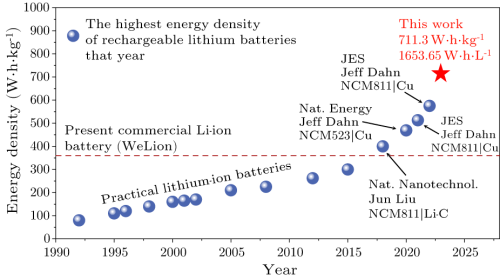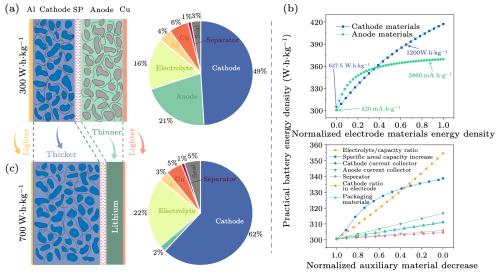Energy & Critical Metals
Researchers in China report 711.3 Wh/kg Li-ion battery cell
In a paper in Chinese Physical Letters, researchers from the Chinese Academy of Sciences report manufacturing practical pouch-type rechargeable lithium…

In a paper in Chinese Physical Letters, researchers from the Chinese Academy of Sciences report manufacturing practical pouch-type rechargeable lithium batteries with a gravimetric energy density of 711.3 Wh⋅kg−1 and a volumetric energy density of 1653.65 Wh⋅L−1. Current advanced practical lithium-ion batteries have an energy density of around 300 Wh⋅kg−1.
Li et al.
The team used high-performance battery materials including a high-capacity lithium-rich manganese-based cathode (LRM) and a thin lithium metal anode with high specific energy, combined with high-loading electrode preparation and lean electrolyte injection.
Battery design: (a) the existing 300 Wh·kg−1 commercial lithium-ion battery; (b) the increase of energy density in practical lithium batteries by increasing active electrode materials’ energy density and decreasing auxiliary materials’ mass; (c) the mass construction of a 700 Wh·kg−1 battery involved in this work. Li et al.
At present, the energy density of advanced commercial lithium-ion batteries has reached the level of 300W·h·kg−1. … Due to a comprehensive consideration of cycling performance, rate performance, safety, environmental adaptability, etc., the proportion of active cathode materials is always low, at the level of 50%, while the proportion of anode materials accounts for 18%–25% and other auxiliary materials take up 25%–30% of the total mass.
Disregarding all the other aspects, only focusing on energy density, approaches like adopting cathode and anode materials with higher specific energy, increasing electrode loading mass, reducing the ratio of electrolyte mass and battery capacity (E/C ), and adopting lighter and thinner collectors, separators, packaging materials, etc. are all feasible to achieve a high value of energy density. After analyzing the design of the existing 300 W·h·kg−1 battery thoroughly, we calculate the dependence between energy density and several main components regardless of the normal functionality of the batteries. The results show that cathode and anode materials, loading mass, and E/C ratio are dominant in improving energy density. … Unfortunately, the change of every single component cannot warrant the battery to reach an energy density of above 400 W·h·kg-1. The fabrication of high-energy density batteries can only be achieved by the synergy of up-mentioned factors.
—Li et al.
The team used a high specific capacity LRM cathode with widened voltage range and 20μm Li metal anode stabilized by a PVDF separator. The one-sided specific area capacity of the cathode exceeds 10mAh·cm−2, and the compact density is greater than 2.6g·cm−3. The current collectors are made of ultra-thin Al (9 μm) & Cu (6 μm) foil, and the E/C ratio is 1.3 g·A−1 ·h−1.
Within the routine charge-discharge voltage range of 2–4.8V, the 9.72Ah full battery exhibits 601.78Wh·kg−1 gravimetric energy density and more than 1175.56Wh·L−1 volumetric energy density [Fig. 4(a)], and the battery discharge capacity has no obvious decline after 3 cycles.
Further extending the operating voltage range to 1.25–4.8 V, the energy contained in the low voltage interval assists the gravimetric energy density up to 701.06 Wh·kg−1 and volumetric energy density to 1621.84 Wh·L−1. Despite a small capacity reduction in the second cycle, the battery capacity shows a high retention of 78.2% in the third cycle. The energy density is 711.3 Wh·kg−1 and 1653.65 Wh·L−1 according to a third party testing report of parallel batteries. The volume change of the initial cell is only 5.09% after the first cycle.
… we should note that there is always a contradictory among the energy density, cycling performance, rate performance, and safety in lithium batteries. Therefore, those parameters still need to be considered comprehensively to meet the demand of specific fields in the future.
—Li et al.
Resources
-
Quan Li et al. (2023) “A 700 Wh kg−1 Rechargeable Pouch Type Lithium Battery” Chinese Phys. Lett. doi: 10.1088/0256-307X/40/4/048201

Uranium Exploration Company Announces Additional Staking in the Athabasca Basin
Source: Streetwise Reports 12/22/2023
Skyharbour Resources Ltd. announced an update from its Canada-based Falcon Project along with additional…
Tesla Launches New Mega Factory Project In Shanghai, Designed To Manufacture 10,000 Megapacks Per Year
Tesla Launches New Mega Factory Project In Shanghai, Designed To Manufacture 10,000 Megapacks Per Year
Tesla has launched a new mega factory…
Giving thanks and taking stock after “a remarkable year”
An end-of-year thank you to our readers, industry colleagues and advertisers before Electric Autonomy breaks from publishing until Jan. 2
The post Giving…


















